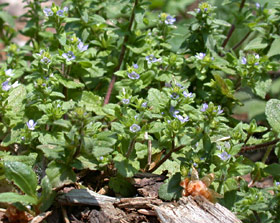Speedwell (Corn Speedwell), Veronica arvensis

UMass Amherst.
IPM Steps to Reduce Speedwell
1. Sample for Pest
Confirm the presence of speedwell before you treat.
Where to find it while inspecting: A grassy annual weed found in lawns and fields. Tolerant of poor soil and heat.
2. Proper ID
Is it speedwell?
Size and Appearance: Low growing, small hairy leafed, spreading. Round to ovate leaves growing opposite (lower leaves rounded, upper leaves more pointed). Flowers are violet-blue on short stalks. Heart-shaped, hairy seed pods.
3. Learn the Pest Biology
What is the life cycle of speedwell?
Life Cycle: A winter annual, blooms from May to September, therefore produces seeds throughout the season, though much fewer in summer. Flowers last one day before they fade to create a seed; new flowers bloom the next day.
Preferred Habitat: Shade or sun, turf as well as disturbed soils along edges and gardens. Thrives in moist, nutrient-rich soils.
4. Determine Threshold
How much speedwell is too much?
Threshold: Act to remove if you find this weed in your high end turf, as it is a long-term seed producers and mowing does little to reduce seed formation.
5. Choose Tactics
Creating a healthy soil condition and understanding turfgrass’s needs is the first step in reducing turf pests. What are the best management practices to reduce speedwell?
Best Management Practices: Irrigate turf if needed to help it compete, however chickweed prefers moist soil and often dies back in summer heat, mow turf at proper height (removing no more than 1/2 of the blade), amend poor soil, choose proper turfgrass seed for your conditions, buy quality seed, overseed thin spots in fall or early spring, remove thatch. Speedwell tolerates shade so it may out-compete turfgrasses that do not. Speedwell roots are shallow and can be removed easily by hand.
Treatment Methods: If speedwell is established in an area of your turf, there are broadleaf herbicide options.
6. Evaluate
Was the tactic successful? Record the date pests were first noted, and the tactic you used, and its success. Use one of our RECORD KEEPING tools.
For More Information:
UMass Amherst: Agriculture and Landscape Program: Veronica arvensis
Remember:
When a pesticide application is necessary, all necessary and required precautions are taken to minimize risk to people and the environment and to minimize risk of pesticide resistance or pest resurgence. Pesticide use in your school may be prohibited or regulated by local policies or state and federal regulations. Risk reduction methods can include, but are not limited to, spot-treatment, the use of gel or paste bait formulations placed in inaccessible locations, injection into a crack or crevice, and other methods that reduce potential exposure.